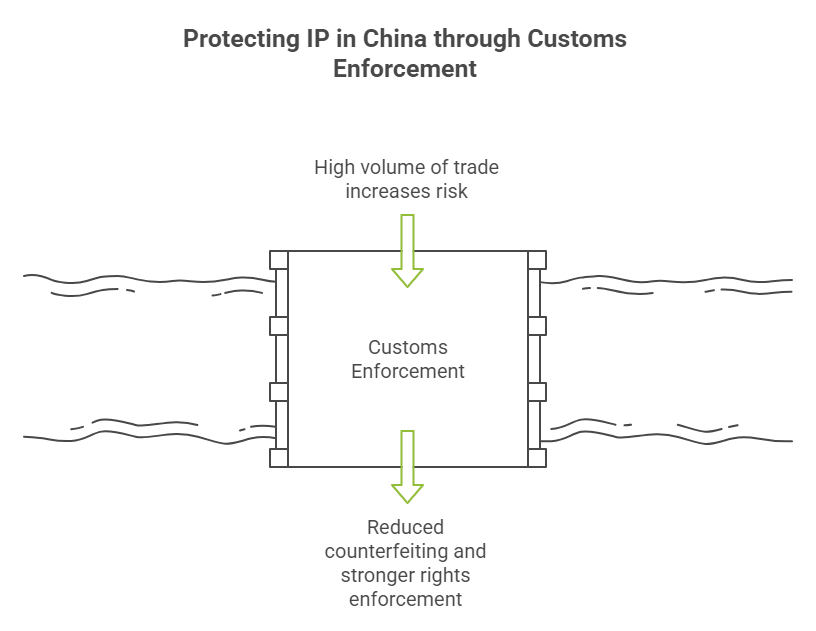For businesses trading with or within China, protecting intellectual property (IP) at the border is a critical defense strategy. Counterfeit goods pose significant risks to revenue, brand reputation, and consumer safety. China’s General Administration of Customs (GACC) operates a robust system for IP rights holders to register their rights and request detention of suspected infringing shipments. Understanding this system is vital for safeguarding your trademarks, patents, and copyrights.

Why Customs IP Protection Matters in China
- Scale of Trade: As the world’s largest trading nation, vast volumes of goods move through Chinese ports daily. This creates opportunities for counterfeiters.
- Proactive Enforcement: Customs officials act as a crucial first line of defense, physically inspecting shipments and intercepting infringing goods before they enter or leave the market.
- Cost-Effective: Detention at the border is often more efficient and less costly than pursuing infringers through the courts after goods have been distributed.
- Deterrence: A strong customs recordal signals to potential infringers that your rights are actively protected.
The Foundation: IP Rights Recordal with GACC
The cornerstone of China’s customs IP protection is the Recordal System. Rights holders must proactively register their eligible IP rights with GACC.
- Eligible Rights:
- Registered Trademarks (China Trademark Office)
- Patents (Invention, Utility Model, Design – China National Intellectual Property Administration)
- Copyrights (and related rights) – Though recordal is highly recommended, enforcement can sometimes occur based on prima facie evidence even without pre-recordal, especially for copyright. Recordal significantly streamlines the process.
- Olympic Symbols, World Expo Symbols.
- Application Process:
- Applicant: The IP rights holder or an authorized agent (like a registered Chinese law firm or patent/trademark agency).
- Where: Online via the GACC’s IP Recordal Filing System.
- Required Documents:
- Application Form.
- Proof of Subject Eligibility (e.g., business license copy).
- Certificate of IP Right (Trademark Registration Certificate, Patent Certificate, Copyright Registration Certificate or compelling evidence of ownership).
- Proof of Identity of Legal Representative.
- Power of Attorney (if applying through an agent).
- Images of the genuine goods and their packaging.
- List of known licensees (if applicable).
- Information on known suspected infringers (optional but helpful).
- Fees: Currently, no official fees are charged for recordal applications.
- Review and Validity:
- GACC reviews applications, typically within 30 working days.
- Upon approval, the recordal is valid for 10 years, coinciding with the validity period of the underlying IP right (or until the IP right expires, if sooner). It can be renewed.
- Recordals must be updated if the IP right itself changes (e.g., renewal, assignment, license scope).
Triggering Customs Action: Detention of Suspected Infringing Goods
Once your rights are recorded (or, in specific copyright cases, with sufficient evidence), you can leverage customs enforcement:
- Ex Officio Action (Customs Initiated):
- During routine inspections or risk profiling, customs officials may identify shipments suspected of containing goods infringing a recorded IP right.
- GACC will notify the recorded rights holder (or agent) immediately upon detention.
- The rights holder typically has 3 working days (extendable by another 10 working days upon request) to:
- Confirm infringement and request seizure.
- Provide a security (bond) to cover potential storage/destruction costs and liabilities if the detention is later found wrongful. The amount is determined by GACC, often based on the value of the detained goods.
- If no confirmation/bond is provided within the deadline, customs releases the goods.
- Application-Based Action (Rights Holder Initiated):
- Rights holders (recorded or unrecorded, but unrecorded face higher evidence hurdles) can proactively apply for detention if they obtain specific intelligence about an imminent shipment containing suspected infringing goods.
- Requires: A written application detailing the suspected shipment (port, expected arrival date, carrier, consignee/consignor, container numbers if possible), proof of IP rights, and preliminary evidence of infringement.
- Security: The applicant must provide a security determined by GACC.
- Timeline: GACC decides whether to detain within 48 hours of receiving a valid application and security. If detained, the rights holder has 20 working days to initiate court proceedings (e.g., file an infringement lawsuit or apply for pre-litigation preservation), otherwise, the goods are released.
What Happens After Detention?
- Investigation: GACC investigates the detention. Both the rights holder and the shipper/importer/exporter can submit evidence and arguments.
- Findings:
- Infringement Confirmed: Goods are confiscated. Rights holder can choose: (a) Donation to public welfare; (b) Auction to non-infringing entity (after removing infringing features); (c) Sale to the rights holder; (d) Destruction. Destruction is often the safest option.
- Infringement Not Confirmed: Goods are released. The security provided by the rights holder (if applicable) may be used to compensate the shipper for losses incurred due to wrongful detention.
- Judicial Action: Regardless of customs’ administrative finding, the rights holder or the shipper can initiate a lawsuit in court to resolve the infringement dispute definitively.
Best Practices for Effective Customs Protection
- Record Your Rights: This is the single most important step. Ensure trademarks, patents, and copyrights are registered in China and recorded with GACC. Regularly verify and update recordals.
- Provide Clear Information: Furnish GACC with high-quality images of genuine products/packaging and detailed information differentiating them from counterfeits. Regularly update information on authorized manufacturers/distributors. Maintain open communication channels with GACC.
- Train Customs Officials: Proactively offer to train customs officials at key ports to recognize your genuine products and common counterfeits.
- Monitor the Market & Supply Chain: Gather intelligence on potential infringers and suspicious shipments. Utilize customs’ application-based detention mechanism effectively when specific intelligence arises.
- Work with Experts: Navigating Chinese IP law and customs procedures requires specialized knowledge. Partner with experienced local IP counsel or specialized verification services to ensure proper recordal, evidence gathering, and response coordination. Verifying the legitimacy of Chinese suppliers and their IP compliance is a crucial first step. Services specializing in comprehensive Company Documents Retrieval and thorough Intellectual Property Verification can provide essential due diligence and evidence support.
Conclusion
China’s customs IP protection system offers a powerful tool for rights holders to combat cross-border counterfeiting. By proactively recording IP rights with GACC, providing clear product information, and actively cooperating with customs authorities, businesses can significantly reduce the flow of infringing goods. While the system requires diligence and sometimes expert guidance, its effectiveness in protecting valuable intellectual property at the critical border checkpoint makes it an indispensable component of any China IP strategy. Understanding the recordal and detention procedures empowers rights holders to take control and secure their market position. For complex cases or ensuring supplier legitimacy, leveraging professional verification services provides an added layer of security in navigating the Chinese market.
